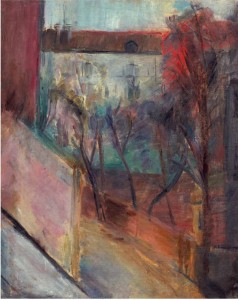Paintings by Vasily Korotevev and Grigory Kostyukhin show a completely different kind of city. It’s Moscow but that’s not the point. The Path of Painting group, which, as Leninrad’s Artists Circle, came into being in 1926, did take a different path, though that path was just as modern and just as much part of the art of the twenties.
Koroteyev and Kostyukhin seem to have deliberately ignored outward signs of their times but to have looked into their less obvious characteristics. They painted old spots in Moscow’s Zamoskvorechye district, quiet little streets, courtyards. This option was a principle: it represented deliberate avoidance of any dialogue with facade culture. Shallow and fictitious historical and political definiteness had nothing to do with their tasks as artists. There is an inner light permeating the entire space of the city as pictured in their paintings and appears to impart to the objects we see in their works an unstable, transitional character. Grigory Kostvukhin’s “Women’s Town” has a mild, dulled pink and green shine to it; it’s not quite clear which time of day and which season of the year it is; but there we also have the choice of a distinct viewpoint that we already know about — we are looking at the city from above, from a window or roof. Vasily Koroteev is also looking at his “Moscow Courtyard” from above — from the window of his room on Novokuznetskaya Street. The city, as seen from the depths of the artist’s personal world, acquires a pulsating bright red-blue-purple light, as if the artist brought life to it. The whole city and the whole world with it acquire a new, human dimension. Everything is full of life, and everything is part of man’s inner world, in other words a product of man’s personal will. Man and the space in which he exists are part of each other physically or bodily, and the art of painting is actually the ability to see the living world and a man as following the same rhythm, and moving and breathing in unison. In 1928, the painting was shown at the Ways of Painting exhibition in Paris. Eighty years later, it remains a living part of the cultural process and keeps its meaning. It has never become an archive document of purely museum value.



